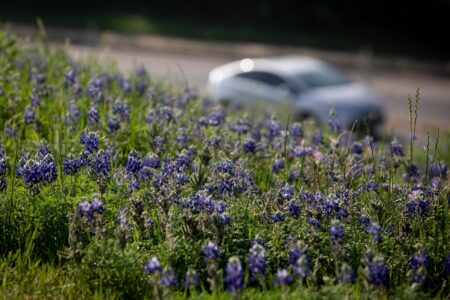
With the spring season set to begin Thursday, Texas' state flower is already beginning to emerge along highways and interstates around Houston. Although some regions of Texas are expected to see fewer bluebonnets than usual this year due to drought, the Houston area should have them in abundance. "They need pretty consistent rainfall as little young seedlings to get established," said Hannah Armstrong, the lead horticulturist at the Lady Bird Johnson Wildflower Center at the University of Texas at Austin.
"Once they're established, they're a bit more resilient. So y'all had much more consistent rains in the fall and throughout the winter and spring than we've had in Central Texas. So, you're going to have a much fluffier display this year.

" While it may appear that bluebonnets naturally take over the medians and roadsides along the majority of Texas highways, Armstrong said the Texas Department of Transportation (TxDOT) plants them. "They spread Lord knows how many seeds every year," she said. “They're really great about seeding out all kinds of native plants, especially the bluebonnets.
They time their mows to allow the plants to flower and go to seed so they're not mowing as the plants are setting bud, which allows for those beautiful displays on the highway." Texas has five native bluebonnet species and while they tend to bloom from the end of March into early May, Armstrong said they germinate in the fall. During the germination period, the flower's leaves can be seen in small clusters that look similar to basil.
"They germinate in the fall, which is, I think, something that people don't realize," she said. "The flowers get a lot of attention, but the foliage is really pretty. It's beautiful in the morning when there's a front on it.
They're very resilient throughout the winter. It can handle our cold snaps, even snow." As spring rolls into summer, Armstrong said the flowers dry out in the heat, twist and "fling" their seeds.
Their roots also add nutrients to the soil once the plant dies. "As the roots die and the plant has lived its life, it releases that nutrient back into the soil," she said. "So people could, rather than pulling bluebonnets that are spent, just sort of cut them at the ground and leave those roots intact to add more nutrients.
" Armstrong said rising temperatures due to climate change might eventually result in bluebonnets blooming earlier in the year. "Inconsistent rain in the fall, drought, warmer temperatures and more sporadic temperatures sort of push the bloom time up," she said. "So they'll be blooming earlier and having kind of a shorter season as the warmer temperatures hit.
".














